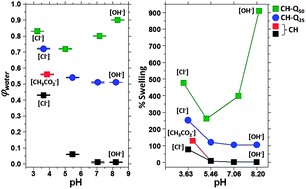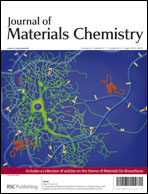This study investigates the swelling of grafted polycationic brushes as a function of pH and anion type. The brushes are chitosan (CH) and chitosans with 27% and 51% degrees of substitution (DS) of quaternary ammonium salts, denoted as CH-Q25 and CH-Q50, respectively. The water content and swelling behaviors are monitored using in situ quartz-crystal microbalance with dissipation (QCM-D). The pH varies from ∼3.5 to 8.5, and the counter anion types include chloride, acetate, and citrate. At fixed pH, the water content and brush swelling increase as the DS increases. While the CH-Q50 brush layer shows symmetric swelling with a minimum near pH = 4.5, the swelling of CH and CH-Q25 is relatively constant as pH decreases from 8.2 to 5.5, and then begins to increase near pH 4. These studies indicate that the symmetric swelling of CH-Q50 is likely attributed to increasing protonation of primary amines at pH values below 6.5 and the quaternary ammonium salts above pH 6.5. At pH 4, the swelling of the CH brush increases upon exchanging the smaller chloride with bulkier acetate anions, which is less effective in screening intra/inter-molecular repulsion. In contrast, upon exchanging the acetate with trifunctional citrate anions, CH and CH-Q25 brushes collapse by 53 and 42%, respectively, because the citrate anions form ionic cross-links. To test antibacterial properties, silicon oxide, CH and CH-Q50 brush layers are exposed to 107–108 cfu ml−1 of S. aureus for two days at 37 °C and to stepped shear stresses at 2 min intervals. While an S. aureus biofilm adheres strongly to silicon oxide and CH for stresses up to 12 dyne per cm2, biofilms on CH-Q50 detach at a relatively low shear stress, 1.5 dyne per cm2. Due to their high degree of swelling that can be tuned via pH, counterion size and type, chitosan and quaternary modified chitosans have potential as responsive coatings for applications including MEMS/NEMS devices and drug eluting implants.


 Please wait while we load your content...
Please wait while we load your content...